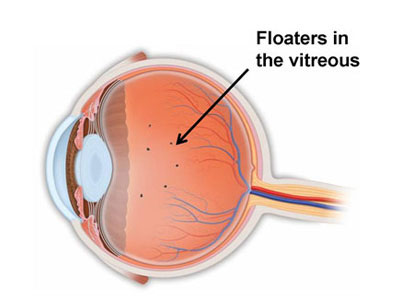
To view a PDF version of this information, click here.

Many people have what are commonly referred to as "floaters". Floaters are described in many different ways by different people. They can look like spots, shadows, curved lines, lacy patterns, or a circle. The distinctive feature of floaters is that they sway and move in the line of vision as the eye moves. Floaters can be a minimal nuisance that is noticed only intermittently, or they can be very bothersome, to the point of interfering with one's regular activities. Also, floaters can be caused by a variety of conditions in the eye, some of which may be serious and require medical attention.
Floaters are caused by anything that is floating in the vitreous jelly that fills the eye. Any sort of particles in the vitreous can cast shadows onto the retina, and depending on the size and shape of the particle, the shadow can take on different shapes, giving rise to floaters. Floaters are most commonly caused by benign aging-related fluid pockets and bits of protein debris that form in the vitreous over time. This is not, however, the only cause of floaters. The same symptoms can occur with many other conditions, including vitreous detachment, retinal detachment, inflammation in the eye, or bleeding in the eye. For this reason, new or changing floaters should never be ignored.
If you experience floaters, particularly if they are new or increasing, you should contact an eye doctor immediately so that an appointment can be made for your eye to be evaluated.

